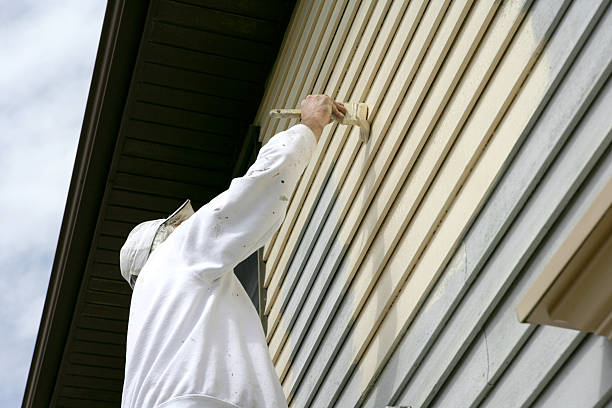Exterior painting is one of the most impactful ways to enhance your home’s curb appeal, protect its structure, and increase its value. Whether you’re considering a fresh coat of paint or a complete color overhaul, understanding the nuances of exterior painting in Fort Lauderdale FL will help you make informed decisions.
Why Exterior Painting Matters
The exterior of your home is the first thing people see, and it serves as a reflection of your personal style. High-quality exterior paint not only beautifies but also protects against weather damage, UV rays, and pests. It’s an investment in your home’s longevity and can significantly boost its market value.
Choosing the Right Paint
When it comes to selecting paint for your home’s exterior, there are a few key factors to consider:
Type of Paint
- Acrylic Paint: This water-based paint is versatile, dries quickly, and is resistant to fading and mildew. It’s a popular choice for many homeowners.
- Oil-Based Paint: Known for its durability and smooth finish, oil-based paint is ideal for wood surfaces. However, it takes longer to dry and has a stronger odor.
Finish Options
- Flat: Offers a matte look and is less reflective, making it great for hiding imperfections but harder to clean.
- Satin: Provides a subtle sheen, which makes it easier to wash while still hiding imperfections.
- Semi-Gloss and Gloss: These finishes are highly reflective and durable, perfect for high-traffic areas, doors, and trim.
Color Selection
Choosing the right color can dramatically alter your home’s appearance. Consider the architectural style of your home, the surrounding landscape, and any homeowners’ association regulations. Neutral colors often provide a timeless look, while bold hues can create a striking statement.
Preparing for Exterior Painting
Proper preparation is crucial for a successful exterior painting project. Here are the essential steps to ensure the best outcome:
Inspect the Surface
Examine the exterior for any signs of damage such as cracks, peeling paint, or rot. Repairing these issues before painting will help the new paint adhere better and last longer.
Clean the Surface
Dirt, mold, and mildew can affect how paint adheres to the surface. Use a pressure washer to thoroughly clean the exterior. If necessary, treat mold and mildew with a solution of water and bleach.
Prime the Surface
Applying a primer is essential, especially on new surfaces or areas where paint has been removed. Primer provides a uniform base and improves paint adhesion, resulting in a more durable finish.
The Painting Process
Once the preparation is complete, it’s time to start painting. Here are some tips for achieving a professional-looking finish:
Use Quality Tools
Investing in high-quality brushes, rollers, and sprayers will make the job easier and result in a smoother finish.
Follow the Right Technique
- Cutting In: Start by painting edges and corners using a brush before rolling the larger areas.
- Roller Technique: Use a roller for expansive surfaces, applying paint in a ‘W’ pattern to avoid streaks.
Consider Weather Conditions
Aim to paint on a dry, overcast day. Direct sunlight can dry paint too quickly, leading to uneven finishes, while painting in wet conditions can affect adhesion.
Maintenance of Exterior Paint
To ensure your exterior paint lasts as long as possible, regular maintenance is essential:
- Inspect Annually: Look for signs of wear, including peeling, fading, or cracking.
- Clean Surfaces: Wash your home’s exterior at least once a year to prevent dirt buildup and mold growth.
- Repaint When Necessary: Depending on the quality of the paint and exposure to elements, you may need to repaint every 5 to 10 years.
Hiring Professional Painters vs. DIY
While DIY exterior painting can be rewarding, it may not always be the best choice for everyone. Here are some pros and cons:
Pros of Hiring Professionals
- Expertise: Professionals have the experience and knowledge to tackle complex projects.
- Time-Saving: They can complete the job more quickly and efficiently than the average homeowner.
- Safety: Professional painters are trained to work safely on ladders and scaffolding.
Cons of Hiring Professionals
- Cost: Hiring a professional can be more expensive than doing it yourself.
- Limited Control: You may have less control over the process and final results compared to a DIY project.
FAQs
How often should I paint my home’s exterior?
Typically, you should repaint every 5 to 10 years, depending on the quality of the paint and the climate conditions in your area.
Can I paint over old paint?
Yes, but it’s essential to properly prepare the surface first. Remove any peeling or damaged paint, clean the surface, and apply a primer if necessary.
What temperature is ideal for exterior painting?
The best temperature for exterior painting is between 50°F and 85°F. Avoid painting in extreme heat or cold, as it can affect the paint’s drying time and finish.
Do I need to use a primer?
Using a primer is recommended, especially for new surfaces or areas with old, damaged paint. It helps improve adhesion and ensures a more durable finish.
What if it rains after I paint?
If rain is forecasted shortly after painting, it’s best to wait until the weather clears. Most exterior paints need at least a few hours to dry before being exposed to moisture.
Conclusion
Professional exterior painting is more than just a cosmetic upgrade; it’s an investment in your home’s longevity and value. Whether you choose to tackle the project yourself or hire professionals, understanding the essentials of exterior painting will ensure you achieve stunning results that enhance your home for years to come.
